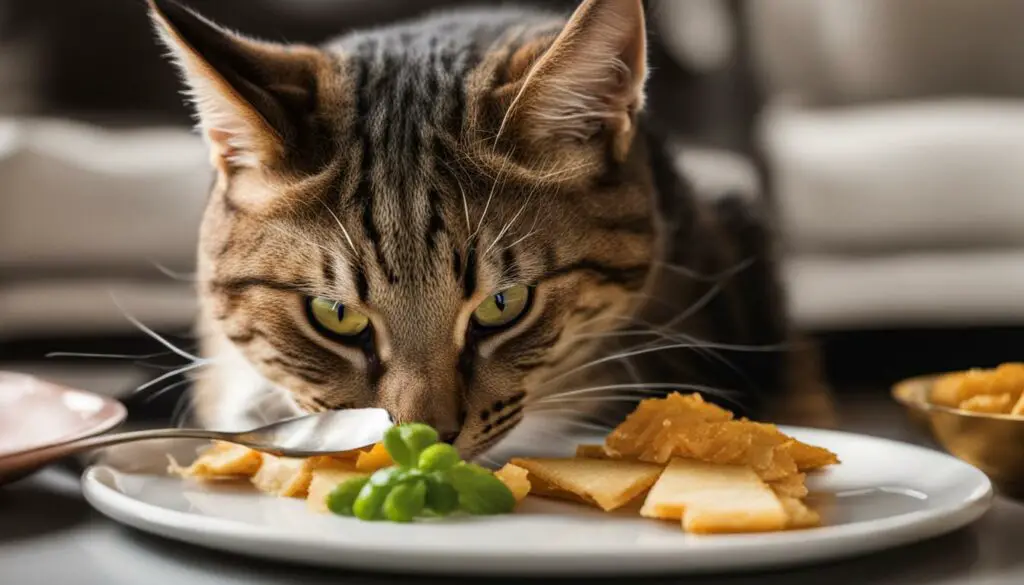Is your cat refusing to eat and exhibiting the strange behavior of trying to bury its food? Don’t worry, you’re not alone. Many cat owners have experienced this perplexing behavior and wondered why their feline friend is behaving this way. In this article, I will help you understand the reasons behind your cat’s refusal to eat and its attempt to bury its food. By gaining insight into your cat’s behavior, you can address any underlying issues and ensure your cat receives the proper nutrition it needs.
Key Takeaways:
- Cats have a natural behavior of burying their food, called caching.
- Reasons why cats bury their food include trying to keep it safe for later, protecting it from other animals, or providing for their kittens.
- Burying food is not inherently unhealthy, but it’s important to address any underlying issues.
- Preventing burying behavior involves adjusting feeding routines, creating a calm dining area, and consulting with a veterinarian if necessary.
- Understanding the instinctual nature of burying behavior can help cat owners interpret their cat’s actions and provide appropriate solutions.
Reasons Why Cats Bury Their Food
Cats may exhibit the behavior of burying their food for various reasons. Understanding these reasons can help cat owners address and manage the behavior effectively. Here are some common reasons why cats bury their food:
- Keeping it safe for later consumption: Cats, especially those who are not very hungry or are given wet food at set mealtimes, may try to bury their food to save it for later.
- Protecting it from other animals: Cats may bury their food to prevent other animals in the household, such as other cats or dogs, from getting to it.
- Providing for their kittens: Female cats with kittens might bury their food as a way to save it for their young ones.
- Feeling rushed during mealtime: If a cat feels rushed while eating, it may try to bury its food as a way to deal with the stressful situation.
- Being overfed: Cats that are being overfed may bury their food as a way to regulate their intake.
Understanding these underlying reasons can help cat owners tailor their approach and ensure that their cats’ nutritional needs are met.
Table: Common Reasons for Cats Burying Their Food
| Reason | Description |
|---|---|
| Keeping it safe for later consumption | Cats may bury their food if they are not very hungry or are given wet food at set mealtimes, saving it for later. |
| Protecting it from other animals | Cats may bury their food to prevent other animals in the household, such as cats or dogs, from getting to it. |
| Providing for their kittens | Female cats with kittens might bury their food as a way to save it for their young ones. |
| Feeling rushed during mealtime | Cats may bury their food if they feel rushed while eating, as a way to cope with the stressful situation. |
| Being overfed | Cats that are being overfed may bury their food as a way to regulate their intake. |
By addressing the specific reasons behind the burying behavior, cat owners can help their cats establish healthier eating habits.
Is Food Caching Unhealthy?
Burying food is not inherently unhealthy for cats. While it may be a puzzling behavior for cat owners, it is essential to understand the underlying reasons behind it. If your cat is burying food instead of eating, it is crucial to determine the cause to ensure your furry friend’s well-being.
Cats may bury their food for various reasons, such as saving it for later consumption, protecting it from other animals, or following their natural instincts. If your cat is burying food because it can’t eat everything at once or is being disturbed during mealtime, it may be beneficial to adjust their feeding routine. However, if your cat’s burying behavior persists and is accompanied by a significant decrease in appetite or weight loss, it may be an indication of an underlying health issue. In such cases, consulting with a veterinarian is recommended to address the situation effectively.
Understanding that cats have a natural instinct to bury their food can help provide insight into their behavior. It is essential to remember that each cat is unique, and their burying behavior may vary. By observing your cat’s actions and addressing any concerns, you can help ensure they receive the necessary nutrition and care they need for a healthy and happy life.
| Reasons for Food Caching | Impact on Cat’s Health |
|---|---|
| Saving food for later consumption | Not inherently unhealthy, but adjustments to feeding routine may be necessary |
| Protecting food from other animals | Not inherently unhealthy, but may require creating a safe and peaceful dining environment |
| Following natural instincts | Not inherently unhealthy, but understanding their behavior can help address any concerns |
Overall, while food caching in cats may seem unusual, it is usually a harmless behavior that can be managed with the right approach. By providing the appropriate feeding methods and seeking veterinary advice when necessary, you can help ensure your cat’s nutritional needs are met and promote their overall well-being.
How to Prevent Burying Behavior
To prevent your cat from burying its food, there are several steps you can take. First, make sure you are feeding your cat the appropriate amount of food for its needs. Overfeeding can lead to the instinctual behavior of burying food. Monitor your cat’s weight and adjust the portion sizes accordingly.
If your cat feels rushed during mealtime, give it more time to eat. Create a calm and peaceful environment by feeding your cat in a quiet area of your home. This will help reduce any stress or distractions that may cause it to bury its food.
If other animals in your household are disturbing your cat during mealtime, consider separating them during feeding. This will give your cat the space it needs to eat without feeling the need to bury its food to protect it from other animals.
If your cat is burying its food due to health issues or a change in appetite, it is important to consult with a veterinarian. They can help determine if there are any underlying health issues that need to be addressed. Your veterinarian may recommend a change in diet or other treatments to help resolve the burying behavior.
The Instinctual Nature of Burying Behavior
Burying food is an instinctual behavior in cats. In the wild, cats would bury their leftovers to protect it from other animals and to have a future food source. This behavior can still be seen in domestic cats, although it may not always serve a practical purpose. Understanding the natural instincts behind burying behavior can help cat owners better interpret their cat’s actions and provide appropriate solutions.
While not all cats exhibit burying behavior, it is important to recognize that it is a natural part of their instinctual repertoire. Some cats may bury their food more persistently than others, while some may not engage in this behavior at all. By acknowledging and accepting these individual differences, cat owners can tailor their approach to managing burying behavior and provide a more personalized solution that meets their cat’s specific needs.
I’ve noticed that my cat often scratches the floor around her bowl after she finishes eating. At first, I was puzzled by this behavior, but then I learned that it’s actually a natural instinct for cats to bury their food. It’s fascinating to see how their ancient instincts are still present in our domesticated feline friends.
The Benefits of Understanding Instinctual Behavior
Understanding the instinctual nature of burying behavior in cats can have several benefits for cat owners. First and foremost, it allows us to better comprehend why our cats engage in this behavior, which can help alleviate any concerns or frustrations we may have. It also helps us create a more enriched and fulfilling environment for our cats by providing them with opportunities to engage in their natural instincts.
Additionally, by recognizing that burying behavior is a normal part of a cat’s behavior, we can avoid trying to suppress or eliminate it entirely. Instead, we can focus on managing the behavior in ways that are both practical and beneficial for our cats. This can include providing appropriate feeding methods, creating a calm and safe eating environment, and offering mental and physical stimulation through toys and activities.
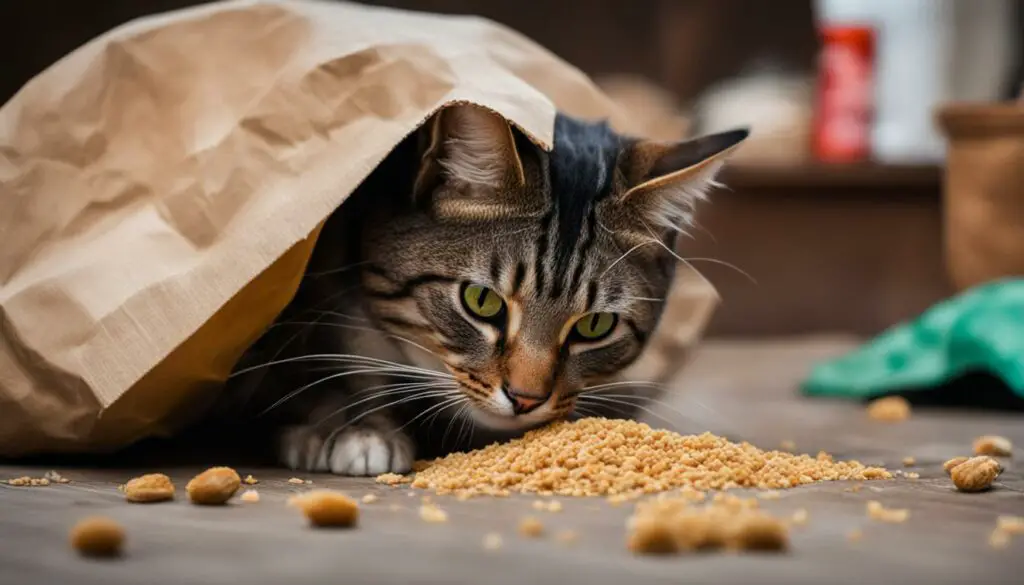
Understanding why cats bury their food has definitely given me a new perspective on my cat’s behavior. I now see it as a natural instinct rather than a strange or unnecessary habit. It’s just another example of how fascinating and unique our feline companions are.
When to Be Concerned
If your cat is not eating and trying to bury its food, it may be a cause for concern. While burying food is usually a natural behavior, it can be indicative of underlying issues when accompanied by a significant decrease in appetite, weight loss, or signs of illness. If you notice these symptoms in your cat, it is important to seek veterinary advice to ensure their well-being.
Observing changes in your cat’s behavior and appetite is crucial in determining when to be concerned. If your cat has stopped eating and started burying its food, it may be a sign of an underlying health issue that requires medical attention. Consulting with a veterinarian can help identify any potential problems and provide the appropriate care and treatment for your cat.
Remember, each cat is unique, and their burying behavior may vary. However, if you have any doubts or concerns about your cat’s burying behavior and appetite, it is always recommended to seek professional advice. Veterinary professionals are equipped with the knowledge and expertise to assess your cat’s overall health and provide necessary guidance to address any concerns.
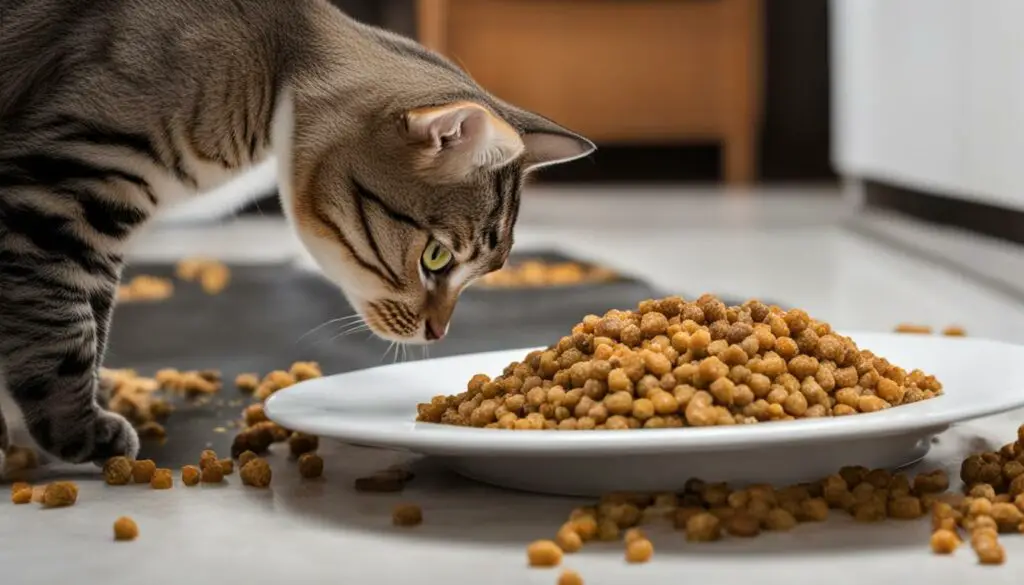
When to Seek Veterinary Advice
If you are unsure about your cat’s burying behavior or if it is causing significant distress or concern, it is always recommended to seek veterinary advice. A veterinarian can assess your cat’s overall health and provide guidance on managing any underlying issues contributing to the burying behavior. By consulting with a professional, you can ensure the best care for your cat and address any potential health or behavioral concerns.
Section 7: Managing Burying Behavior
If your cat’s burying behavior is not accompanied by any concerning symptoms, there are steps you can take to manage the behavior. Ensuring a calm and quiet environment during mealtime can help reduce stress and distractions. Feeding smaller, more frequent meals can also prevent your cat from feeling the need to bury food for later. If your cat prefers grazing, providing dry food that is less likely to be buried can be an option. Monitoring your cat’s feeding habits and making adjustments accordingly can help manage burying behavior.
Additionally, environmental enrichment can play a significant role in managing burying behavior in cats. Providing mentally stimulating toys and activities can help redirect your cat’s attention and provide an outlet for their natural hunting instincts. Creating a peaceful and safe environment during mealtime can also reduce stress and anxiety. By enriching your cat’s environment, you can promote overall well-being and address any underlying behavioral issues contributing to burying behavior.
It is important to recognize that not all cats exhibit the same burying behavior. Each cat is unique and may have different reasons for engaging in this behavior. Some cats may exhibit more persistent burying behavior, while others may not engage in it at all. Understanding and appreciating your cat’s individual differences can help you tailor your approach to managing burying behavior and provide a more personalized solution that meets their specific needs.
Table: Comparing Different Approaches to Managing Burying Behavior
| Approach | Advantages | Disadvantages |
|---|---|---|
| Feeding smaller, more frequent meals | – Reduces the need to bury excess food | – Requires more frequent feeding |
| Providing dry food for grazing | – Less likely to be buried | – May not provide the necessary moisture for some cats |
| Creating a calm and safe eating environment | – Reduces stress and distractions during mealtime | – May require adjustments to the household environment |
| Providing environmental enrichment | – Offers mental stimulation and an outlet for natural instincts | – Requires additional resources and planning |
By implementing these strategies and understanding your cat’s individual needs, you can effectively manage burying behavior and ensure your cat’s overall well-being. However, if you have any concerns about your cat’s burying behavior or appetite, it is always recommended to consult with a veterinarian for professional guidance and support.
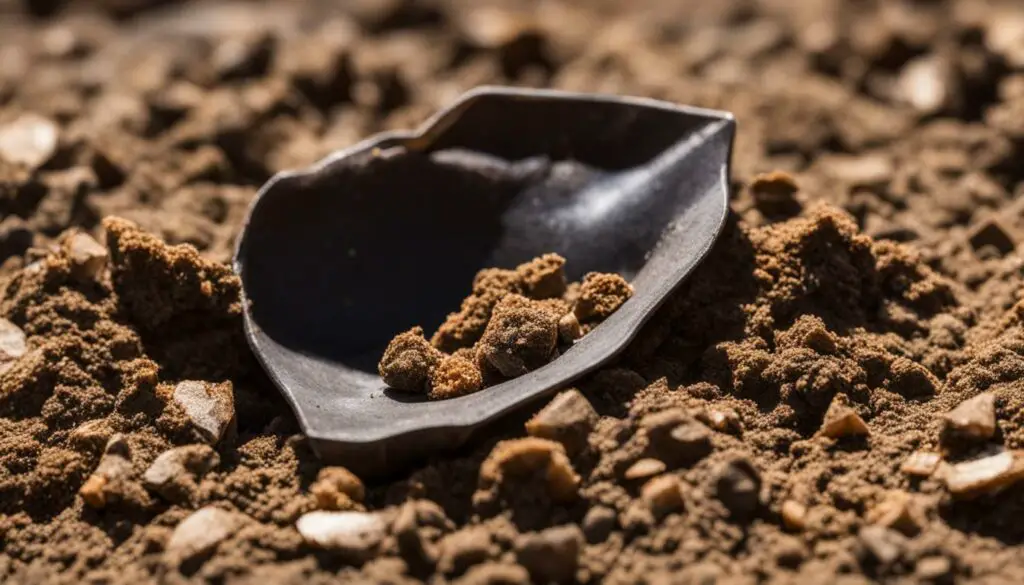
Understanding the Reasons Behind Burying Behavior
When it comes to a cat’s burying behavior, there are several underlying reasons that can drive this peculiar habit. It’s essential to understand these motivations in order to effectively address and manage your cat’s behavior. One possible reason for burying food is the instinct to protect it. Just like their wild ancestors, domestic cats may have a natural inclination to safeguard their food from other animals and preserve it for future consumption.
Another reason behind burying behavior is the desire to save food for later. Your cat may bury its food because it’s full or not hungry at that particular moment. By burying the food, it’s essentially stashing it away for future meals. This behavior can be especially common in cats that are fed wet food at specific mealtimes, as they may see it as an opportunity to save some for later.
Additionally, cats may bury their food to cover up unwanted scents or hide evidence of their presence. This behavior is deeply ingrained in their instincts, as it helps them avoid attracting predators or rivals. By burying their food, cats perceive that they are reducing the chances of being detected by potential threats.
| Reasons Behind Burying Behavior | Explanation |
|---|---|
| Instinct to protect food | Cats have an innate drive to safeguard their food from other animals, just like their wild ancestors. |
| Desire to save food for later | Cats may bury their food to save it for future consumption, especially if they are full or not hungry. |
| Need to cover up unwanted scents | Burying food allows cats to hide evidence of their presence and reduce the chances of attracting predators or rivals. |
Addressing Burying Behavior
Understanding the reasons behind your cat’s burying behavior is the first step in effectively addressing and managing it. If your cat is burying food simply to protect it or save it for later, you can try adjusting their feeding routine. Offering smaller, more frequent meals can help prevent your cat from feeling the need to bury food. Alternatively, if your cat’s burying behavior is causing significant distress or interfering with their eating habits, it’s advisable to consult with a veterinarian for further guidance.
Creating a peaceful and undisturbed dining environment can also be beneficial in managing burying behavior. By providing your cat with a quiet and stress-free space to eat, you can help alleviate any concerns or rush they may feel during mealtime. Additionally, ensuring that the food you provide is fresh and appealing can help reduce the desire to bury or save it for later.
It’s important to remember that each cat is unique, and their burying behavior may vary. Some cats may exhibit more persistent burying behavior than others. By taking the time to understand your cat’s individual needs and preferences, you can tailor your approach to managing their behavior. With patience, consistency, and a holistic understanding of their burying behavior, you can help your cat establish healthier eating habits.
The Importance of Appropriate Feeding Methods
When it comes to addressing your cat’s burying behavior and ensuring their nutritional needs are met, providing appropriate feeding methods is crucial. By implementing the right feeding routine, you can help prevent or manage the behavior effectively. Here are some key considerations:
Evaluating Portion Sizes and Frequency:
Feeding the right amount of food per day and offering smaller, more frequent meals can help reduce the urge to bury food. This approach is especially beneficial for cats that feel rushed during mealtime or have a tendency to overeat. By dividing their daily portion into multiple smaller meals, you can promote healthier eating habits and discourage burying behavior.
Creating a Calm Environment:
A peaceful and quiet environment during mealtime can minimize stress and distractions, thereby reducing the likelihood of burying behavior. Choose a calm area in your home where your cat can eat without interruptions from other pets or loud noises. Providing a separate feeding space for each cat can also help prevent competition and reduce burying tendencies.
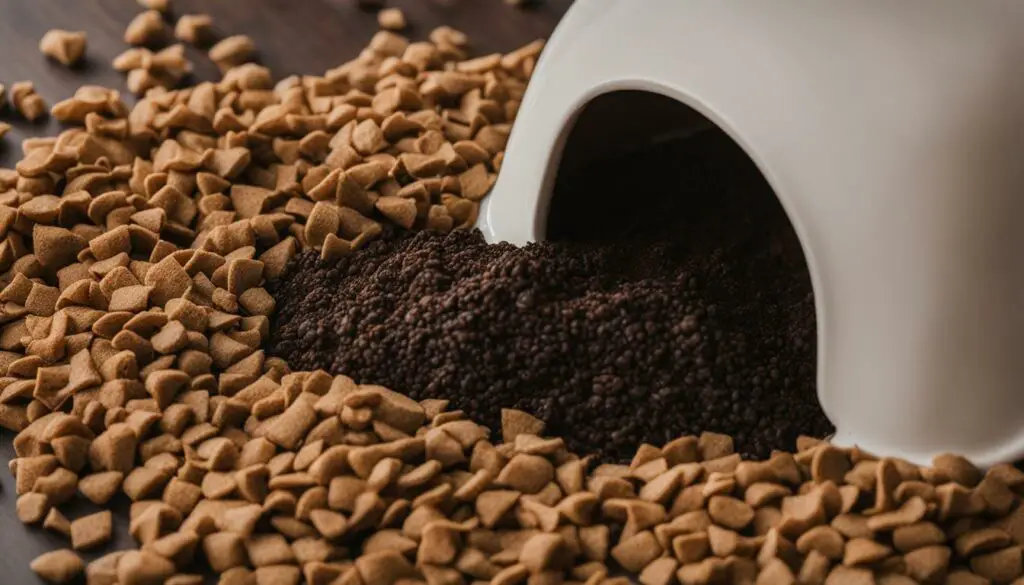
Choosing the Right Type of Food:
The type of food you offer can also play a role in your cat’s burying behavior. Wet food, for example, may be more likely to trigger burying instincts due to its texture and smell. If your cat tends to bury their wet food, you may consider transitioning to dry food or a combination of both to reduce burying behavior. However, it is essential to ensure that their nutritional needs are still adequately met.
By focusing on appropriate feeding methods, you can help your cat establish a positive relationship with food and minimize burying behavior. Remember to evaluate portion sizes, create a calm environment, and choose the right type of food for your feline companion. If you have any concerns or questions about your cat’s burying behavior, consult with your veterinarian for personalized guidance and support.
Addressing Other Behavioral Concerns
While burying behavior in cats is often a natural instinct with various reasons, it can sometimes be accompanied by other behavioral concerns. If your cat is exhibiting unusual behavior with food burying, it is important to observe any additional changes in their behavior. This can include excessive scratching around the bowl, aggression towards other animals during mealtime, or anxiety-related behaviors.
Identifying and addressing these additional concerns is crucial for a holistic approach to managing burying behavior in cats. By understanding the underlying causes and triggers, you can develop a more well-rounded plan to provide your cat with the support and care they need.
Addressing Anxiety-Related Behavior:
In some cases, burying behavior may be a manifestation of underlying anxiety or stress in your cat. To address this, it is important to create a calm and safe environment during mealtime. Provide a quiet and undisturbed space for your cat to eat, away from loud noises or other distractions. You can also consider incorporating environmental enrichment activities, such as puzzle toys or interactive feeders, to help alleviate anxiety and engage your cat’s natural instincts.
Resolving Aggression During Mealtime:
If your cat exhibits aggressive behavior towards other animals during mealtime, it may be necessary to separate them during feeding. This can help reduce any tension or competition that may trigger burying behavior. Provide each pet with their own designated feeding area to ensure they can eat without feeling threatened or rushed.
Consulting with a Professional:
If you are unable to address your cat’s burying behavior or if it is causing significant distress, it is advisable to seek veterinary advice. A veterinarian can conduct a thorough evaluation of your cat’s behavior and provide guidance tailored to their specific needs. They may recommend behavior modification techniques, additional environmental enrichment, or even referral to a professional animal behaviorist if necessary.
By addressing any additional behavioral concerns alongside burying behavior, you can help create a more comprehensive and effective approach to supporting your cat’s overall well-being.
| Behavioral Concern | Recommended Approach |
|---|---|
| Anxiety-related behavior | – Create a calm and safe environment during mealtime – Provide environmental enrichment activities – Consult with a veterinarian |
| Aggression during mealtime | – Separate animals during feeding – Provide designated feeding areas – Ensure each pet feels safe and comfortable |
| Other concerning behaviors | – Observe and document changes in behavior – Seek veterinary advice for professional guidance – Consider referral to an animal behaviorist if needed |
Seeking Veterinary Advice
If you are unsure about your cat’s burying behavior or if it is causing significant distress or concern, it is always recommended to seek veterinary advice. A veterinarian can assess your cat’s overall health and provide guidance on managing any underlying issues contributing to the burying behavior. By consulting with a professional, you can ensure the best care for your cat and address any potential health or behavioral concerns.
When it comes to understanding your cat’s unusual behavior with food burying, a veterinarian is the best resource to turn to. They have the knowledge and expertise to determine if the behavior is indicative of an underlying health issue or if it is simply a natural instinct. By discussing the behavior with a veterinarian, you can gain valuable insights and recommendations specific to your cat’s individual needs.
Remember, your cat’s well-being is of utmost importance, and seeking veterinary advice is crucial in ensuring their overall health and happiness.
To summarize, if you have noticed your cat showing strange behavior with food burying, do not hesitate to reach out to a veterinarian for professional guidance and support. They can help you understand the underlying reasons behind this behavior and provide appropriate solutions tailored to your cat’s specific needs.
The Role of Environmental Enrichment
Environmental enrichment plays a crucial role in managing burying behavior in cats. By providing mentally stimulating toys and activities, you can redirect your cat’s attention and provide an outlet for their natural hunting instincts. This helps to reduce their urge to bury food instead of eating it. Creating a peaceful and safe environment during mealtime also contributes to minimizing stress and anxiety. By enriching your cat’s environment, you can promote their overall well-being and address any underlying behavioral issues that may contribute to burying behavior.
In addition to providing toys and activities, you can also consider incorporating interactive feeding methods, such as puzzle feeders or food-dispensing toys. These not only engage your cat’s mind but also make mealtime a fun and rewarding experience. By making mealtime more interactive and engaging, you can help divert your cat’s attention away from burying their food and encourage them to eat.
| Benefits of Environmental Enrichment | How to Implement |
|---|---|
| Stimulates mental and physical activity | Provide a variety of toys and puzzles |
| Reduces stress and anxiety | Create a quiet and safe eating environment |
| Prevents boredom and destructive behavior | Rotate toys regularly to maintain interest |
| Promotes natural hunting instincts | Use interactive feeding methods |
Remember, every cat is unique, so it’s important to observe and understand your cat’s preferences and behaviors when implementing environmental enrichment. You may need to experiment with different toys and activities to find what works best for your cat. By providing a stimulating and enriching environment, you can help your cat develop healthier eating habits and decrease their tendency to bury food instead of eating it.
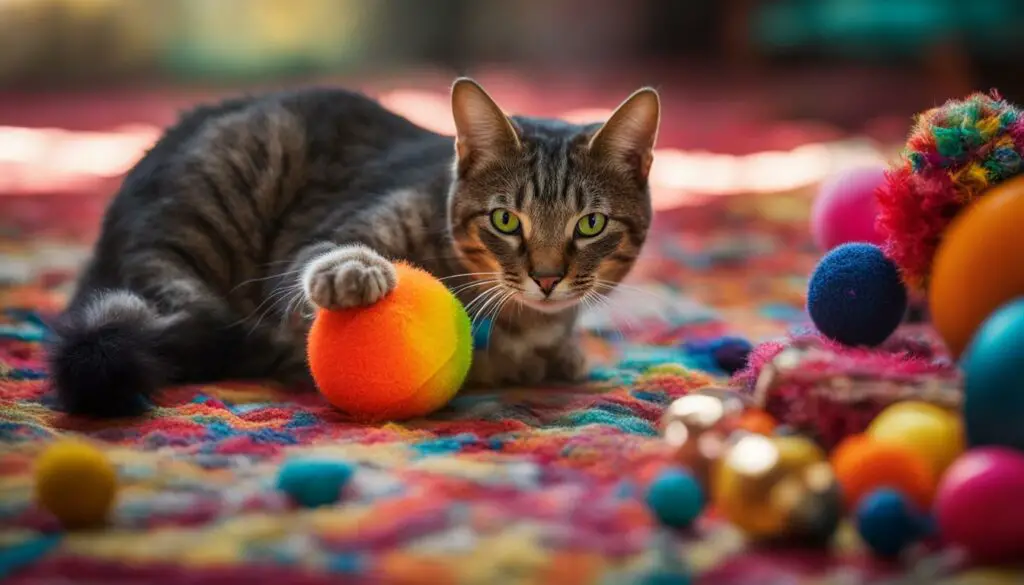
“Environmental enrichment is an essential aspect of cat care. By providing an enriched environment, we can fulfill their natural instincts and promote their overall well-being.” – Dr. Jane Smith, Veterinarian
Recognizing Individual Cat Differences
When it comes to burying behavior in cats, it is important to recognize and appreciate their individual differences. Not all cats exhibit the same burying behavior, and understanding your cat’s unique characteristics can help tailor your approach to managing this behavior effectively.
Some cats may engage in more persistent burying behavior, while others may not bury their food at all. The reasons behind this behavior can vary from cat to cat, and it is important to observe and understand your cat’s specific actions and motivations.
By recognizing your cat’s individual differences, you can provide a more personalized solution that meets their specific needs. This may involve creating a calm and quiet eating environment, adjusting their feeding routine, or addressing any underlying health or behavioral concerns.
Establishing Healthy Eating Habits
Eating habits play a crucial role in maintaining the overall health and well-being of our feline friends. If your cat is refusing to eat and burying their food, it is important to address this behavior and establish healthy eating habits. By understanding the underlying reasons and taking the necessary steps, you can ensure that your cat receives the proper nutrition they need.
One of the first steps in establishing healthy eating habits is providing a balanced diet. Consult with your veterinarian to determine the appropriate type and amount of food for your cat’s specific needs. Whether it’s wet or dry food, it is essential to offer a nutritionally complete diet that meets all of their dietary requirements.
Creating a calm and safe eating environment can also encourage healthy eating habits. Find a quiet and peaceful location for your cat’s feeding area, away from any distractions or stressors. This will help them feel relaxed and comfortable during mealtime, reducing the urge to bury their food.
If your cat continues to refuse food and bury it, it may be a sign of an underlying health issue. In such cases, it is crucial to seek veterinary advice. A veterinarian can conduct a thorough examination and recommend any necessary treatments or changes in diet to address the issue.
| Steps to establish healthy eating habits: |
|---|
| 1. Provide a balanced diet: Consult with your veterinarian to determine the appropriate type and amount of food for your cat’s specific needs. |
| 2. Create a calm eating environment: Find a quiet and peaceful location for your cat’s feeding area, away from distractions and stressors. |
| 3. Seek veterinary advice: If your cat continues to refuse food and bury it, consult with a veterinarian to rule out any underlying health issues. |
By following these steps and addressing your cat’s eating behavior, you can help them establish healthy eating habits and ensure their overall well-being. Remember to be patient and understanding as you work towards a positive change in their eating habits.
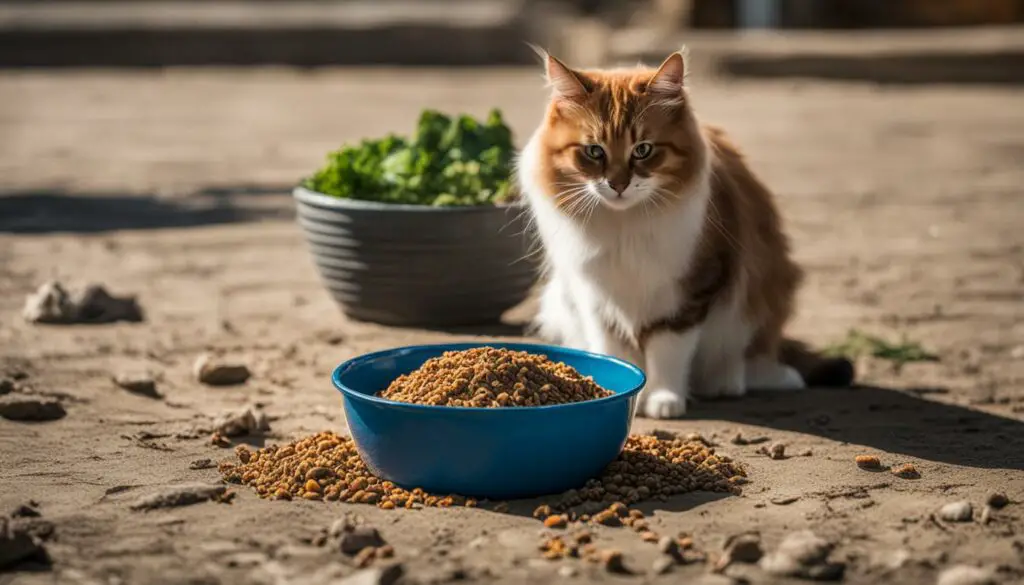
Conclusion
Understanding why your cat is not eating and trying to bury food is essential for their overall well-being. Burying behavior in cats is a natural instinct rooted in their ancestral hunting habits. Cats may bury their food to keep it safe for later consumption, protect it from other animals, or provide for their young. However, it is important to address the underlying cause of this behavior to ensure your cat gets the nutrition it needs.
If your cat’s burying behavior is accompanied by a significant decrease in appetite or signs of illness, it is crucial to seek veterinary advice. These symptoms may indicate an underlying health issue that requires medical attention. On the other hand, if the burying behavior is not accompanied by concerning symptoms, there are steps you can take to manage it. Creating a calm and peaceful environment during mealtime, feeding smaller, more frequent meals, and monitoring your cat’s eating habits can all help prevent or reduce burying behavior.
Remember that each cat is unique, and individual differences in burying behavior should be recognized. By understanding your cat’s specific needs and providing appropriate feeding methods, you can help establish healthier eating habits. Regular veterinary check-ups are also important for detecting any underlying health issues that may impact your cat’s appetite and burying behavior. If you have any concerns about your cat’s burying behavior or appetite, it is always best to consult with a veterinarian for professional guidance and support.
FAQ
Why does my cat try to bury its food?
Cats may try to bury their food for various reasons, including saving it for later, protecting it from other animals, providing for their kittens, feeling rushed during mealtime, or being overfed.
Is burying food unhealthy for cats?
Burying food itself is not unhealthy for cats. However, it is important to address the underlying cause of the behavior and ensure your cat is receiving the right nutrition.
How can I prevent my cat from burying its food?
To prevent your cat from burying food, you can adjust their feeding routine, create a calm eating environment, and address any health or appetite issues that may be contributing to the behavior.
Why do cats have the instinct to bury their food?
Burying food is an instinctual behavior in cats that stems from their wild ancestry, where burying leftovers helped protect the food from other animals and served as a future food source.
When should I be concerned about my cat’s burying behavior?
If your cat’s burying behavior is accompanied by a significant decrease in appetite, weight loss, or signs of illness, it is important to seek veterinary advice as these may indicate underlying health issues.
How can I manage my cat’s burying behavior?
By addressing the underlying cause, such as adjusting their feeding routine or creating a quiet eating area, you can help manage your cat’s burying behavior and establish healthier eating habits.
What are the reasons behind my cat’s burying behavior?
Cats bury their food for various reasons, including protecting it, saving it for later, or covering unwanted scents. Understanding the specific reasons can help you respond effectively to your cat’s behavior.
Why is it important to use appropriate feeding methods?
Using appropriate feeding methods, such as providing the right amount of food and creating a calm eating environment, can help prevent or manage your cat’s burying behavior and promote healthier eating habits.
Are there other behavioral concerns associated with burying behavior?
Burying behavior in cats may be accompanied by other behavioral concerns, such as excessive scratching around the bowl or aggression during mealtime. Identifying and addressing these concerns can help manage burying behavior more effectively.
When should I seek veterinary advice regarding my cat’s burying behavior?
If you have any concerns about your cat’s burying behavior or appetite, it is recommended to consult with a veterinarian for professional guidance. They can assess your cat’s health and provide appropriate advice and support.
How can environmental enrichment help with burying behavior?
Providing mentally stimulating toys and creating a peaceful eating environment can help reduce stress and redirect your cat’s attention away from burying behavior. This can promote overall well-being and address underlying behavioral issues.
Why do cats exhibit individual differences in burying behavior?
Each cat is unique and may have different reasons for engaging in burying behavior. Understanding and appreciating these individual differences can help you tailor your approach to managing burying behavior and meet your cat’s specific needs.
How can I establish healthy eating habits in my cat?
By addressing and managing burying behavior, providing balanced meals, appropriate portion sizes, and a calm eating environment, you can help your cat establish healthy eating habits and ensure their overall well-being.
Source Links
- https://www.catpointers.com/why-does-cat-bury-food/
- https://www.hepper.com/why-do-cats-sometimes-bury-their-food/
- https://excitedcats.com/why-does-my-cat-try-to-bury-her-food/

